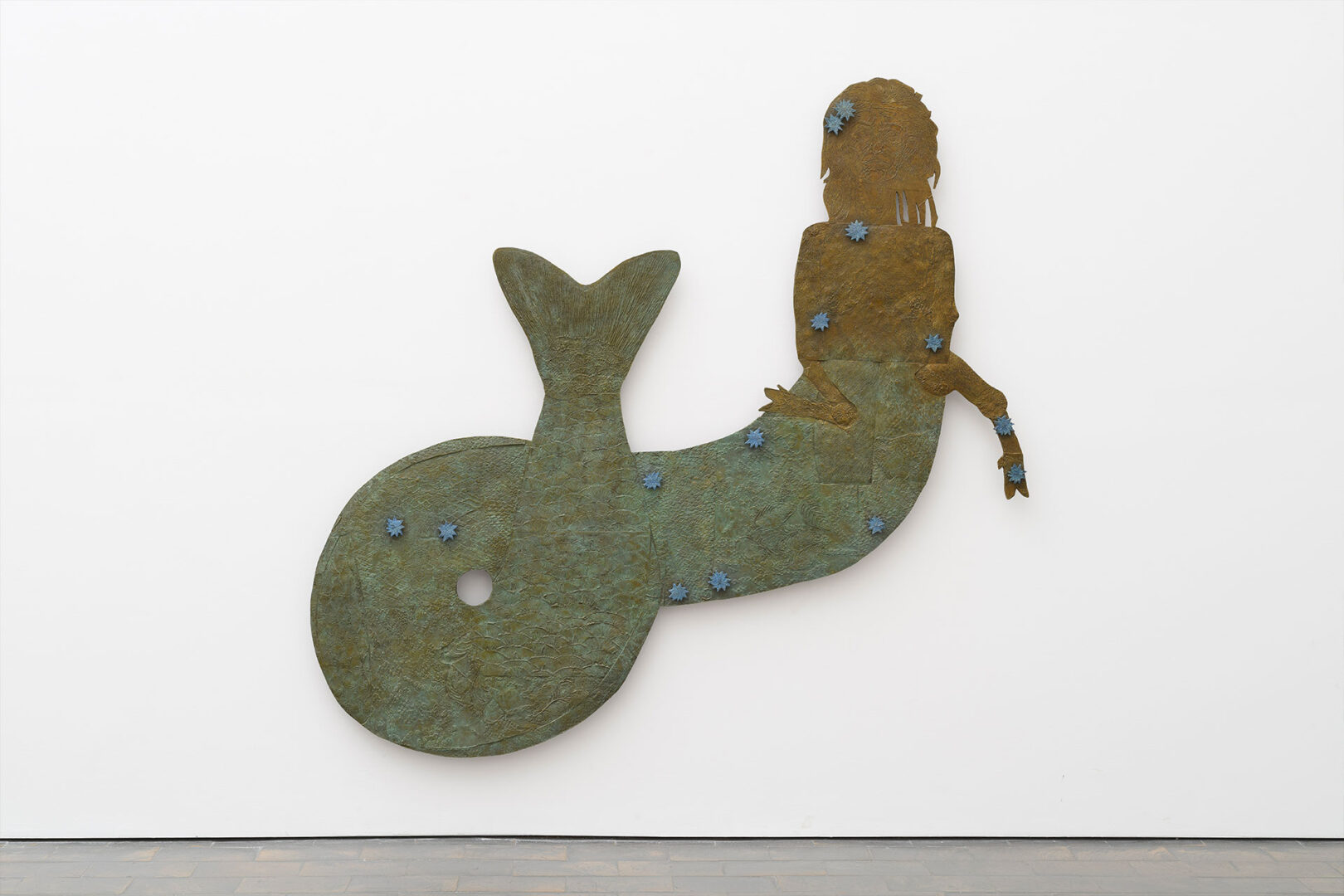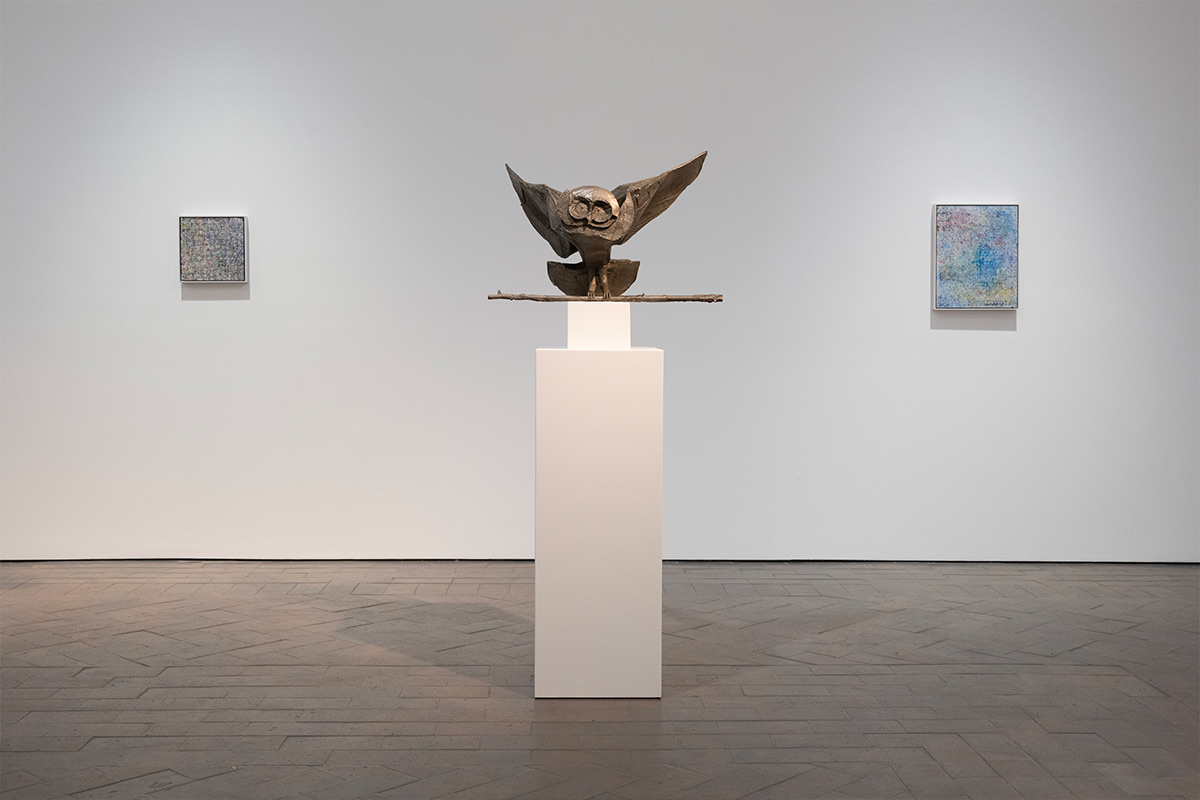Bronze sculptures and small-scale paintings are set up inside the Galleria Lorcan O’Neill as within a temple or a church
In 2006, Kiki Smith was recognized by TIME Magazine as one of the TIME 100: The People Who Shape Our World. Today Smith resembles one figure stepping out of one of her works, with long wavy and silver hair, big blue eyes, and constellations tattooed with blue dots on the arms.
Kiki Smith at Galleria Lorcan O’Neill
Inspired by the Mediterranean, Kiki Smith returns to the Galleria Lorcan O’Neill with hybrid creatures and visualizations of the cosmos. Bronze sculptures and small-scale paintings are set up inside the gallery as within a sacred space, a temple, or a church: two statues of breeding goats welcome visitors, and the casts of their organs evoke ancient Greek sacrifices and divinations.
The exhibition took years in the making, and it involved long walks around the Greek myths and periods of reflection in her studio. «I am an old-fashioned artist», affirmed Kiki Smith. «I need time in my studio to produce works».
The myth of the Greek Islands
Kiki Smith has always been fascinated by legends, fairy tales, and religious icons from around the world. From the ’90, the artist started incorporating animals, domestic objects, and narrative tropes from classical mythology and folk tales. In 2019, Kiki Smith was invited to present a site-specific project at the DESTE Foundation Project Space in Hydra, a former slaughterhouse perched on the sea’s edge.
The installation Kiki Smith conceived was Memory. It combined natural and fantastic elements into a multi-piece composition that reflects the lived and imagined Memory of the slaughterhouse — a stage for sacrifices — and the Hydra region itself. In the manifesto of the exhibition, she wrote: «When the sky comes down from heaven, and the blood shall fill the sea. That has been happening for time immemorial».
Beyond the skin
Early works from the 1980s emerged from explosive changes in political, social, and cultural conditions marked by the AIDS crisis, a fervent discourse on sexuality and gender, and feminist activism. As one of the first female artists to focus on depicting women in society, Kiki Smith transgressed the border of the skin and put the organs and intestines on the outside.
She had taken the human body — the world’s oldest art form — and turned it into something contemporary. Concerned with internal biological processes of waste and regeneration, Kiki Smith has subverted the sculptural tradition of the eroticized female form, exploring the naked female body and its intimate performance of essential functions.
Until the Hydra installation, Smith hadn’t done anything with organs for twenty years: «I was once on the island of Bequia, of St. Vincent and Grenadines, where they hunted whales from small boats and slaughtered goats. One day a goat’s entrails floated in the water as we swam and then washed up on the sands. So I made photographs and drawings of the organs, which got me drawing again after several years of not doing so».
Figurative art and the animal kingdom
Since the early 1990s, Smith has become increasingly interested in alternative narratives, exploring history, myths, legends and tales, religious beliefs, and the traditions of nonwestern cultures. The artist often incorporates the human body as a form that unites us with one another while also highlighting our interconnectedness with other non-human players: birds, wolves, wild forests, and starlit skies feature prominently.
As author Maggie Wright points out: «In Smith’s art, change expands to nurture various forms. Humans turn to animals, animals to other animals; new beings are collaged from each. Bronze oxides, candles melt, and sunlight reemerges daily».
Mix and match
Installed on the gallery’s walls, Siren and Enchantment, two sculptures of mermaids cast as sheets of bronze with drawn lines in relief, hover ethereally between flatness and three-dimensionality. The figures are self-portraits: both have Smith’s face and flowing hair, but their furry, breasted torsos have goat arms, and their bottom halves are mermaids’ tails.
Animals play an essential role in the entire exhibition. At the intersection between humans and the natural world, they carry symbolic meanings and embody human values while keeping a bound to nature and its constant renewal.
Stars and sky
Also, astrology and astronomy have always been recurring interests for Kiki Smith: on her arms, the stars tattooed symbolize the Egyptian goddess of the sky, Nut, whose body stretched across the earth and was covered in stars. According to legend, Nut eats the sun every night, and it exits her digestive system in the morning.
The elements are collaged together from separate stories in her sculptures exhibited at the Galleria Lorcan O’Neill. They relate to different factors: sky, earth, and sea. From head to tail, each sculpture features an assortment of raised stars, like brooches or tattoos, which map the constellation of Capricorn. Born in January, Kiki Smith happens to be a Capricorn herself, and she found amusement in incorporating her image into the work. The interpretation of stars through astronomy and astrology also recur in Smith’s new body of paintings depicting the night sky and in Sungrazer IV and the bronze sculpture of a comet.
An artistic DNA
Kiki Smith grew up in an artistic family. Her mother, Jane Lawrence, was a celebrated soprano, and her father, Tony Smith, an architect, a painter, and a pioneer of minimalist sculpture. Mark Rothko, Jackson Pollock, and Barnett Newman were frequent visitors to the Smiths’ home, and Kiki Smith grew up surrounded by abstract artists and artworks.
Only after her father died in 1980 did she decide to become an artist, exploring themes of mortality and decay in drawings, prints, and sculptures. Her investigation of the body addresses the human condition, topics of age, death, wounding and healing, birth, sexuality, gender, and Memory.
Over the past three decades, Smith has explored the aspects of human existence through her works.
Multiple materials, multiple experimentations
There is no medium that Smith hasn’t tried: she is a draughtsperson, a printmaker, and a sculptor who has worked with every imaginable material. She uses a wide variety of materials to continuously expand and evolve a body of work that includes sculpture, printmaking, photography, drawing, and textiles.
There is an owl carved in wood with an additive sculptural process and an experiment with lenses among the sculptures. Looking through those eyes, an upside-down view of perspective appears.
What Kiki Smith is interested in is that space where things converge.
Kiki Smith
Kiki Smith (Nuremberg, 1954. Lives and works in New York) has been known since the 1980s for her multidisciplinary work that explores embodiment and the natural world. She recently had a major retrospective at Haus der Kunst, Munich, which traveled to the Sara Hildén Art Museum, Tampere, Finland, and the Belvedere Museum, Vienna. A site-specific exhibition at Deste Foundation Project Space in Hydra, Greece; a solo show at Monnaie de Paris.




















